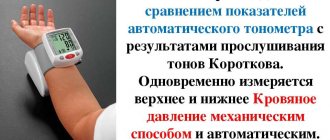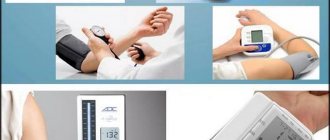Device of mechanical tonometers
A mechanical tonometer consists of: a shoulder cuff, a bulb (air pump), a stethoscope, and a pressure gauge.
Depending on the manufacturer and model, tonometers can have different configurations and accessories: the tonometer can be supplied with a stethoscope built into the cuff, purchased separately or without it at all. Also, for ease of use, some tonometers have a pressure gauge combined with a bulb.
Mechanical tonometer CS Medica CS-107 Mechanical tonometer Little Doctor LD-70 Mechanical shock-resistant tonometer Little Doctor Shock Protection LD-91 Mechanical tonometer Microlife BP AG1-40
Let us consider the device of a mechanical tonometer in more detail:
Cuff
Mechanical blood pressure monitors boast a large range of cuff sizes (cuffs are available for babies, children, teenagers, and adults). Large sizes are suitable for measuring blood pressure not only on the shoulder, but also on the legs.
Pear (supercharger)
It has two valves - a check valve and a dump valve (see photo below). The principle of operation is extremely simple: when you press the bulb, air is pumped into the cuff, while the check valve prevents the air from escaping. A relief valve is provided for smooth air release.
Stethoscope
Designed to listen to heart sounds while measuring blood pressure.
Pressure gauge
Displays the result of blood pressure measurement. When choosing a tonometer, pay attention to the pressure gauge; it is best that it has a large display and a metal case.
Read in this article:
- Design and principle of operation of a mechanical tonometer
- Automatic blood pressure monitor device
- How does an automatic blood pressure monitor measure blood pressure?
- Features of wrist tonometers and semi-automatic devices
- How to choose the right tonometer?
- Convenient and accurate instruments for measuring pressure
Blood pressure is an important indicator of the functioning of the circulatory system, the heart and the entire body as a whole. To measure this parameter, instruments called tonometers are used. They differ in the principle of operation and functionality, in design and method of use. To choose the right device for home use, it is worth understanding how the tonometer works and how it is designed.
Advantages and disadvantages
Advantages of mechanical tonometers:
- Small price.
- High accuracy.
- They fail less often.
- All components are interchangeable.
- Does not depend on power sources.
- Light weight and compact.
Also, mechanical tonometers have one significant drawback - to use a mechanical tonometer, you must have good hearing and a certain skill in measuring blood pressure, otherwise the whole procedure of measuring your own pressure will not make any sense. However, this problem can be solved if you ask a knowledgeable person to measure your blood pressure, and at the same time he will show you how to do it correctly.
Design and principle of operation of a mechanical tonometer
Tonometers are either mechanical or automatic. There are also semi-automatic devices that can be classified into the second group. Each such device has its own design and mechanism of action.
A mechanical tonometer works using the auscultatory method of measuring pressure. This method of recording indicators was invented at the beginning of the 20th century and is still successfully used to this day. The design of the tonometer has not changed over the past decades; it consists of:
- Cuffs that fit on the shoulder between the elbow and shoulder joints;
- Supercharger - a pump that pumps air into the cuff;
- A pressure gauge showing the degree of air pressure in the cuff;
- A phonendoscope, with the help of which heart sounds are heard (they are also called Korotkoff sounds).
The operating principle of this type of tonometer involves detecting noise by ear. The cuff is placed on the arm and air is pumped into it until the artery is completely clamped. After increasing the pressure by another 30-40 mm Hg. the air is gradually released. This leads to the opening of the artery and the resumption of blood flow, which is accompanied by a certain sound. At the moment such noise appears, a digital indicator is recorded on the pressure gauge; it will be the value of the upper (systolic) pressure. When blood pressure decreases, a characteristic sound also appears, which is how the lower (diastolic) pressure is determined.
The most popular models and their costs
One of the most modern hand-held models with a phonendoscope is the Shock Protection LD-91. It can be used both at home and by ambulance paramedics, doctors in hospitals and clinics.
The features of the device are:
- low price - 1175 rubles;
- low weight compared to metal analogues, compliance with all impact resistance standards;
- The downside is the possible fragility of the plastic case.
If used carefully, the device will work for at least two to three years.
The Little Doctor LD-70NR tonometer without a phonendoscope is characterized by the presence of a metal needle-type valve. It is recommended to operate at certain temperatures, namely from 10 to 40 degrees and humidity from 85%, but not less. The device has no age restrictions, however, diagnostics can only be carried out if a cuff of the correct size is used.
The advantages include the presence of a mesh filter and high build quality. A relative disadvantage is the need to subsequently purchase a phonendoscope. Cost 730 rub.
The next mechanical blood pressure monitor is the Microlife BP AG1-20, which comes with a stethoscope. It is intended not only for medical professionals, but also for use at home.
The features of the model are:
- the presence of a bulb with a special needle valve, due to which air is released more smoothly;
- acceptable cost - 1020 rubles;
- The kit includes a stethoscope and a storage bag.
Considering the modern design and ease of use of the device, attention is focused on its lack of negative aspects.
Another device that deserves attention is the IAD-01-2A tonometer, which boasts an expanded set of equipment. It includes a set of age-related cuffs, as well as a special storage bag and a stethoscope. Speaking about different cuffs, pay attention to the following types: enlarged (from 25 to 52 cm), standard - from 22 to 36 cm and children's from 9 cm or more.
The advantages of the kit include a comfortable belt and a special bag with compartments for documents. Perhaps the main disadvantage is the high cost, namely 5,400 rubles. At the same time, the tonometer can be used not only at home, but also by medical specialists, for example, working in kindergartens.
Automatic blood pressure monitor device
Automatic devices operate differently. To understand how an electronic tonometer works, you need to have an understanding of its design and the oscillometric measurement method.
The design of the automatic device includes:
- An electronic board with a display installed on it - it is responsible for controlling the buttons and pressure sensor;
- Pump for pumping air into the cuff;
- A sensor that records the level of pressure in the cuff. It also reads the pulse, upper and lower pressure, determines the presence of arrhythmia, i.e. heart rhythm disturbances;
- A valve that allows air to slowly deflate from the cuff when measuring pressure;
- Valve for quick air release.
Understanding what a tonometer consists of, it is easier to understand the mechanism of its operation and the rules of use.
Main characteristics of tonometers
Easy to use
Since older people regularly use the tonometer, the simplicity of the device is important to them. Some people find it difficult to remember the sequence of keystrokes or any other additional steps to turn on the tonometer; in an alarming situation, you can get confused and not be able to use it. Therefore, most modern tonometers have 1-2 keys - nothing more.
Photo: https://pixabay.com/photos/blood-pressure-monitor-health-1749577/
Price
The price of a tonometer is an important factor for many people, because a tonometer, like any other electronic device, is not cheap. However, the price does not depend on the accuracy of the measurement, but on additional functions that may not be needed.
Tonometer type
Some people do not trust automatic blood pressure monitors and prefer manual ones - because they cannot make a mistake. However, not everyone can and knows how to use a manual device. A mechanical tonometer is also not suitable for people with hearing impairments - the tones may not be heard immediately, and the measurement result will be completely different.
Additional functions
Everything here is individual - some people really need them, while others can do without them. The most common are arrhythmia indication, memory for past measurements and color illumination.
- The arrhythmia indication is useful for people suffering from arrhythmia attacks - the tonometer will be an important tool for recognizing them and taking action.
- Color lighting is useful for those who are just starting to use a tonometer - the device will tell you how much the pressure level differs from the norm, without the need to remember or look at blood pressure levels in normal conditions and at different degrees of hypertension.
- Memory for the last few measurements is useful for those who regularly monitor blood pressure - in order to assess the dynamics of the condition and the effectiveness of treatment, sometimes it is necessary to check the blood pressure value with the previous one.
- Some tonometers have a function for reading data , which helps people with low vision.
How does an automatic blood pressure monitor measure blood pressure?
The operation of the automatic tonometer is structured as follows:
- The cuff is fixed on the shoulder (in some models - on the wrist);
- Pressing the button starts the compressor, which begins to fill the cuff with air;
- A special sensor installed on the electronic board monitors the amount of air pressure;
- After reaching the upper value, the pump stops pumping air;
- The air is gradually released due to the corresponding valve;
- At the same time, the pressure sensor measures the heart rate;
- The moment of recording the most powerful blows is recorded as the upper blood pressure indicator;
- The moment the shock subsides is determined by the sensor as the lower pressure.
Then the device finally bleeds the air from the cuff and displays the measurement results on the display.
In other words, measuring blood pressure using the oscillometric method is the recording of fluctuations in air pressure in the tonometer cuff. These fluctuations (oscillations) appear due to the influence of blood flow in the compressed area of the artery. Using an electronic system, the indicators are converted into electrical signals, and then an automatic system analyzes them and displays them in digital form.
Automatic tonometers operate on batteries, accumulators or mains. Some models combine several power options. It is worth considering that the batteries last for a relatively short time. Rechargeable batteries are a better option because they can be recharged. The ability to operate on mains power may also be useful for home use. Such devices include a network cable.
Features of wrist tonometers and semi-automatic devices
To measure blood pressure, you can use a tonometer that is worn on your wrist. They work in a similar way to conventional automatic tonometers, determining pressure and pulse values and displaying them on the display in the form of numbers. The only caveat is that readings are taken from the radial artery, where the amplitude of the pulse wave is less.
The difference between semi-automatic devices is the manual control of the pump. The person must pump up the air himself, and after reaching the desired pressure, the device automatically releases the pressure, releasing the air.
This difference is also associated with a slightly different design of the device. The design consists of a body with electronic filling, to which a cuff is attached, like an electronic blood pressure monitor. But there is also a mechanical bulb for pumping air, like mechanical models.
The cuff is fixed on the arm, and air is pumped into it using a bulb. Then you need to open the small valve on the bulb to gradually release the air. The electronic unit contains sensors that record the necessary sounds, so a phonendoscope is not required.
Manufacturers
Who makes blood pressure monitors? The most famous companies today are Omron, Microlife and AND.
Omron
A Japanese company whose products are of the highest quality. These devices can detect arrhythmia and record even minor hand movements. Tonometers often come with storage bags. The service center of this company is always easy to reach. Unfortunately, Omron devices also have disadvantages: the price is quite high.
Microlife
These tonometers are produced by a Swiss company that specializes in the manufacture of various equipment for hospitals. The Microlife BP 3AC1-1 device has proven itself especially well. Tonometers are convenient and durable. They have built-in memory, which is divided into blocks. Thanks to this, measurement results can be stored in different cells. This is very convenient if the tonometer is used by several people. The price of the device is affordable.
AND
This company also produces various medical equipment. The tonometers produced by her are very high quality. The range includes special models that have additional functions.
It is impossible to answer unequivocally the question of which is the best tonometer to purchase.
Before purchasing, you need to consult a doctor, visit medical forums and read reviews. This is the only way to choose a convenient, high-quality and accurate device.
When purchasing, you should carefully ensure that the warranty card is not only written out, but also filled out correctly. It must indicate the serial number and model, as well as the date, month and year of purchase. Finally, the seller and buyer must sign for it. In the future, if necessary, with this coupon it will be possible to obtain warranty service at an authorized center, that is, specialists will replace the necessary part or carry out repairs free of charge (provided that the failure of the tonometer was due to the fault of the manufacturer).
The address of the service center must also be written on the coupon.
How to choose the right tonometer?
You should choose a tonometer taking into account its design features. For example, to use a mechanical device, good hearing is required to distinguish tones, and vision to correctly evaluate the readings of the pressure gauge. It is quite difficult to measure your own pressure with such a device; you usually need the help of another person.
But devices of this type are inexpensive and do not require a power source. They are often used by employees of medical institutions who have quite a lot of experience working with such devices.
Automatic blood pressure monitors are convenient for measuring blood pressure at home. All you have to do is put the cuff on correctly and press the button, and the device will do the rest. In addition, many automatic blood pressure monitors are equipped with many useful functions:
- Store the obtained indicators in memory for one or more people;
- Calculate average pressure values for a certain period;
- Compare pressure with standards and report deviations;
- Display time and date;
- Automatically turns off when inactive;
- Shows battery discharge level. There are models of tonometers with backlit screens and large numbers to make it easier for people with low vision to measure blood pressure. Some devices have touch buttons for ease of use.
It is worth paying attention to models that synchronize with applications for mobile devices and computer programs. Such tonometers transmit data via USB, which makes it possible to analyze pressure dynamics, provide this information to the doctor during a consultation, and monitor the influence of various factors on the functioning of the heart and blood vessels.
How does posture affect blood pressure readings and which one should you take?
To accurately determine blood pressure, you need to achieve maximum muscle relaxation. Therefore, it is recommended to sit on a chair or chair with a backrest for several minutes before taking measurements. In this case, you cannot cross or cross your legs over one another, as this may result in the arteries being compressed. And this will already lead to a change in indicators.
The hands should not be in a hanging position; they should be placed on the table so that they are parallel to the heart. You should also avoid squeezing with clothing. It is recommended to sit in this position for ten minutes before the procedure, without talking to anyone, without watching TV or making active movements. Otherwise, the indicators may not be true. It is not prohibited to measure blood pressure in a supine position, but all of the above rules must be followed.
Correct body position when measuring blood pressure
For the accuracy of the indicators, you need to find out on which hand the test should take place. To determine this, you need to measure the pressure on both hands about ten times with intervals of two to three minutes. After the indicators from the left and right hands are recorded in two columns, analysis is performed. The pressure should be measured on the arm on which the result is higher.
Differing indicators on both hands are not considered a deviation, and this is due to the anatomical feature of the functioning of the heart muscle. If the result is the same or differs, but only slightly, then the test should be carried out on the right hand, and for left-handed people - on the left.
The tonometer cuff should be located on the bare part of the arm, two centimeters above the elbow. If it is located above the heart, the measurement result will be underestimated, and if lower, it will be overestimated.
Inaccuracy can be decisive, since if you move a couple of centimeters in either direction from the level of the heart muscle, you can get readings two millimeters of mercury more or less. In this case, the cuff must be tightened evenly so that it covers the entire arm and is secured with Velcro. The needle on the pressure gauge must be at the zero position before starting the procedure.
Correct cuff position










